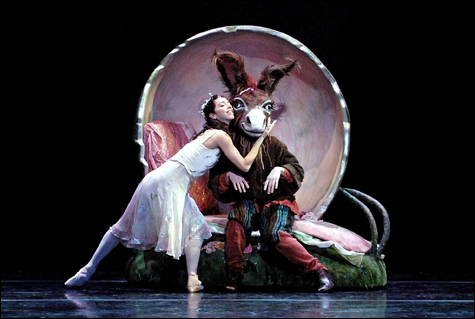
A MIDSUMMER NIGHT’S DREAM: Did we mention the cute donkey?
|
The bad news this year was that we lost the annual Celebrity Series of Boston–sponsored visit from one of the world’s major ballet companies. (Withdrawal of funding by Bank of America was the culprit.) The good news is that we still have our own major company, Boston Ballet, and it made its first international tour — to Spain — in more than a decade, attracting attention worldwide. Now maybe Boston and Massachusetts will take notice. We also got a new dance space, the Barbara Lee Family Foundation Theater in the new ICA. Here’s 2007 as seen by Marcia B. Siegel, Janine Parker, and myself.
A Midsummer Night’s Dream
When it served his purposes, George Balanchine was a wonderful storyteller and role creator, and A Midsummer Night’s Dream is one of his variations on the traditional full-length-ballet formula. His expansive celebration — telling the whole of Shakespeare’s complicated story in the first act, then giving us a second-act wedding celebration with a guest ensemble furnishing the entertainment — provides an antidote to the hyperactive, flavorless contemporary ballets we see everywhere. The piece invokes all the resources of a great ballet company: virtuosity, ensemble, acting, comedy, and the ability to create a poetic image. The dancers of Boston Ballet, in the company’s February production at the Wang Theatre, met this challenge admirably.
The Big Apple Circus
Founded 30 years ago, the Big Apple Circus, which pitched its tent in City Hall Plaza this spring, is the circus as collective madness: the impossibly risky stunts, the zany props and prop wielders, the clowning misfits and grotesques, all with the audience seated in a shallow amphitheater and performers perching at the edge of the ring to shake hands and recruit volunteers for their acts. Australian Justin Case enlisted a man and a little girl from the audience to join him in calisthenics and balloon play, but his specialty is bikes, especially the kind that keep falling apart. He’s the ideal Big Apple performer — amusing, resourceful, slightly demented.
Brake the Eyes
The focal point of Boston Ballet resident choreographer Jorma Elo’s fourth piece for the company, which it premiered in May, was Larissa Ponomarenko, who, moving like one of Droßelmeier’s mechanical dolls in The Nutcracker, would draw on an imaginary slate and try out words and phrases (in Russian), showing, once again, that she’s Boston Ballet’s Ms. Inner Child as well as its Ms. White Act. She took to Elo’s displacements like a kid in a roomful of new toys, giving them hustle and flow (those developpés!) without any smoothing over. When Elo was summoned on stage at the end of the opening-night curtain call, he knelt momentarily in homage to her. Good for him.
Paul Taylor
Many artists talk a good game of dissent, but Paul Taylor is one of the few real resisters around these days. His Jacob’s Pillow programs in July included the 1962 Aureole, the new De Sueños (one of his danse macabre fantasies, inspired by the Day of the Dead), and his 2006 ditty Troilus and Cressida (reduced), wherein, to Ponchielli’s “Dance of the Hours,” his dancers scamper through 15 minutes of love, rape, deception, kidnap, ballet, Martha Graham, and the Trojan War. Aureole and Troilus and Cressida (reduced) also appeared on his November Celebrity Series program at the Shubert Theatre, accompanied by the new Lines of Loss — a succession of soloists and duos who rage and lament to unrelated selections of music ranging from Guillaume de Machaut to Arvo Pärt and Alfred Schnittke — and his 1975 Bach-violin-concerto exploration, Esplanade, which since its creation has evolved into a bouncy, almost slapstick company rout.
Elizabeth Streb
Elizabeth Streb has changed the name of what she does again: the show of “extreme action” she brought to the Institute of Contemporary Art in February was called “Streb vs. Gravity.” The ferociously physical choreography seemed a little less slam-bam and a little more airborne than it used to, but an hour and a half with Streb still celebrates bodies locked in combat with the laws of the universe. Challenge is what Streb is all about, and having demolished one impossible barrier, she and her seven heroic dancers are ready for the next.
Prometheus Dance
All three dances on Prometheus Dance’s Memorial Day–weekend program at Boston Conservatory Theater seemed to tell of women’s travails and their temporary deliverance. Choreographed by Diane Arvanites-Noya and Tommy Neblett over three years, Dievas Mannu/Full Moon (2006), Knowing We Can Never Know (2003), and Devil’s Wedding (2006) were presented under the collective title “Devil’s Wedding.” All 10 performers were women, and from dance to dance, they shared a movement vocabulary that suggested pain, struggle, solace, and submission to unseen but unbreakable constraints.